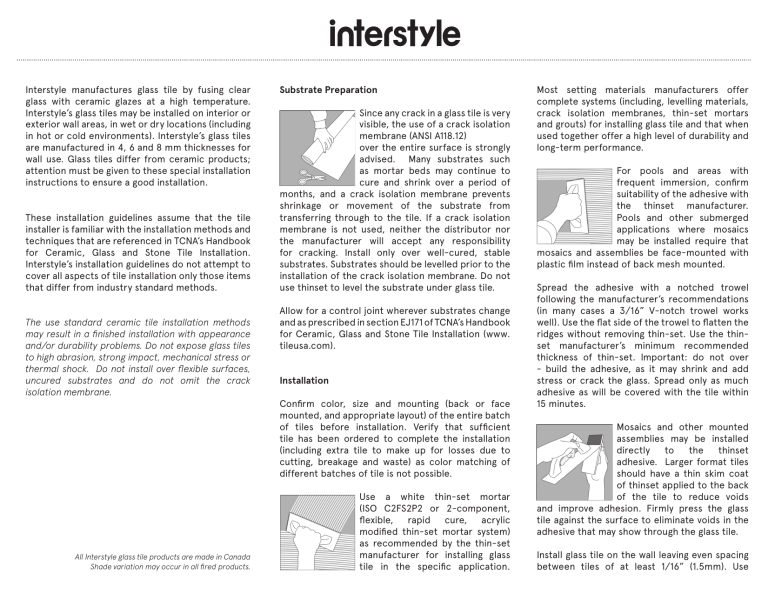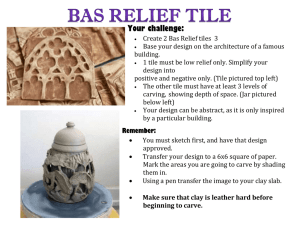this document in PDF format

Interstyle manufactures glass tile by fusing clear glass with ceramic glazes at a high temperature.
Interstyle’s glass tiles may be installed on interior or exterior wall areas, in wet or dry locations (including in hot or cold environments). Interstyle’s glass tiles are manufactured in 4, 6 and 8 mm thicknesses for wall use. Glass tiles differ from ceramic products; attention must be given to these special installation instructions to ensure a good installation.
These installation guidelines assume that the tile installer is familiar with the installation methods and techniques that are referenced in TCNA’s Handbook for Ceramic, Glass and Stone Tile Installation.
Interstyle’s installation guidelines do not attempt to cover all aspects of tile installation only those items that differ from industry standard methods.
The use standard ceramic tile installation methods may result in a finished installation with appearance and/or durability problems. Do not expose glass tiles to high abrasion, strong impact, mechanical stress or thermal shock. Do not install over flexible surfaces, uncured substrates and do not omit the crack isolation membrane.
All Interstyle glass tile products are made in Canada
Shade variation may occur in all fired products.
Substrate Preparation
Since any crack in a glass tile is very visible, the use of a crack isolation membrane (ANSI A118.12) over the entire surface is strongly advised. Many substrates such as mortar beds may continue to cure and shrink over a period of months, and a crack isolation membrane prevents shrinkage or movement of the substrate from transferring through to the tile. If a crack isolation membrane is not used, neither the distributor nor the manufacturer will accept any responsibility for cracking. Install only over well-cured, stable substrates. Substrates should be levelled prior to the installation of the crack isolation membrane. Do not use thinset to level the substrate under glass tile.
Allow for a control joint wherever substrates change and as prescribed in section EJ171 of TCNA’s Handbook for Ceramic, Glass and Stone Tile Installation (www.
tileusa.com).
Installation
Confirm color, size and mounting (back or face mounted, and appropriate layout) of the entire batch of tiles before installation. Verify that sufficient tile has been ordered to complete the installation
(including extra tile to make up for losses due to cutting, breakage and waste) as color matching of different batches of tile is not possible.
Use a white thin-set mortar
(ISO C2FS2P2 or 2-component, flexible, rapid cure, acrylic modified thin-set mortar system) as recommended by the thin-set manufacturer for installing glass tile in the specific application.
Most setting materials manufacturers offer complete systems (including, levelling materials, crack isolation membranes, thin-set mortars and grouts) for installing glass tile and that when used together offer a high level of durability and long-term performance.
For pools and areas with frequent immersion, confirm suitability of the adhesive with the thinset manufacturer.
Pools and other submerged applications where mosaics may be installed require that mosaics and assemblies be face-mounted with plastic film instead of back mesh mounted.
Spread the adhesive with a notched trowel following the manufacturer’s recommendations
(in many cases a 3/16” V-notch trowel works well). Use the flat side of the trowel to flatten the ridges without removing thin-set. Use the thinset manufacturer’s minimum recommended thickness of thin-set. Important: do not over
- build the adhesive, as it may shrink and add stress or crack the glass. Spread only as much adhesive as will be covered with the tile within
15 minutes.
Mosaics and other mounted assemblies may be installed directly to the thinset adhesive. Larger format tiles should have a thin skim coat of thinset applied to the back of the tile to reduce voids and improve adhesion. Firmly press the glass tile against the surface to eliminate voids in the adhesive that may show through the glass tile.
Install glass tile on the wall leaving even spacing between tiles of at least 1/16” (1.5mm). Use
(at least 24 hours). Grout with an un-sanded grout to prevent scratching of the surface.
Cutting
Glass tile should be cut using a wet saw fitted with a diamond blade designed for cutting glass. A proper blade for cutting glass is thin, made with a soft metal compound that exposes fine diamond cutting chips and has a continuous rim to reduce chipping. The use of a standard ceramic tile blade will chip the glass. Orient the tile so that the blade rotates into the glazed side first to minimize chipping.
Use plenty of water or lubricant to keep the blade and glass tile cool. Whenever possible cut edges should be placed into corners where they can be covered or hidden.
Straight cuts generally do not result in additional stress to the glass tile, but notched cuts may add stress and cause cracking of the glass at the inside corner of the tile. A standard ceramic tile cutter
(score and break method) is not recommended.
Cutting Curves – A ring or band saw designed for cutting glass makes cutting curves easy, - curves and holes can be cut most accurately by the use of a waterjet machine. of the bit. A temporary guide can be made out of a scrap piece of plywood drilled with a hole slightly larger than the coring bit. Holding the guide over the desired location of the hole in the tile, slowly start drilling from the back of the tile, then complete the hole from the face of the tile to prevent glass from chipping off on the exit side of the hole.
Important – Drill holes 1/8” (3mm) larger than any anchors you plan to use. To prevent stress transfer from the fixture to the glass tile ensure anchors are well secured to the structure (not only to the substrate) and do not allow fixtures to rest directly on the glass tile. This is particularly important in the case of frameless shower doors and hardware.
Cleaning
For routine cleaning, use any non-abrasive cleaning compound recommended for either glass or tile (such as ammonia and water, penetrating sealer may be used with matte finish or frosted glass to facilitate clean up of cooking oils. vinegar and water, etc.). Follow rinsing instructions carefully. A
Drilling
Drilling a hole requires the use of a drill bit or coring bit designed specifically for glass. Ensure that sufficient cooling water or liquid lubricant is used. If the drill and glass tile cannot be securely clamped in place, use a guide to assist alignment
Interstyle Ceramic & Glass Ltd.
3625 Brighton Avenue
Burnaby, BC, Canada, V5A 3H5
1-800-667-1566
1-604 421-7229 info@interstyleglass.com
www.interstyleglass.com
©2016 Interstyle Ceramic & Glass Ltd
Printed in Canada 160705




